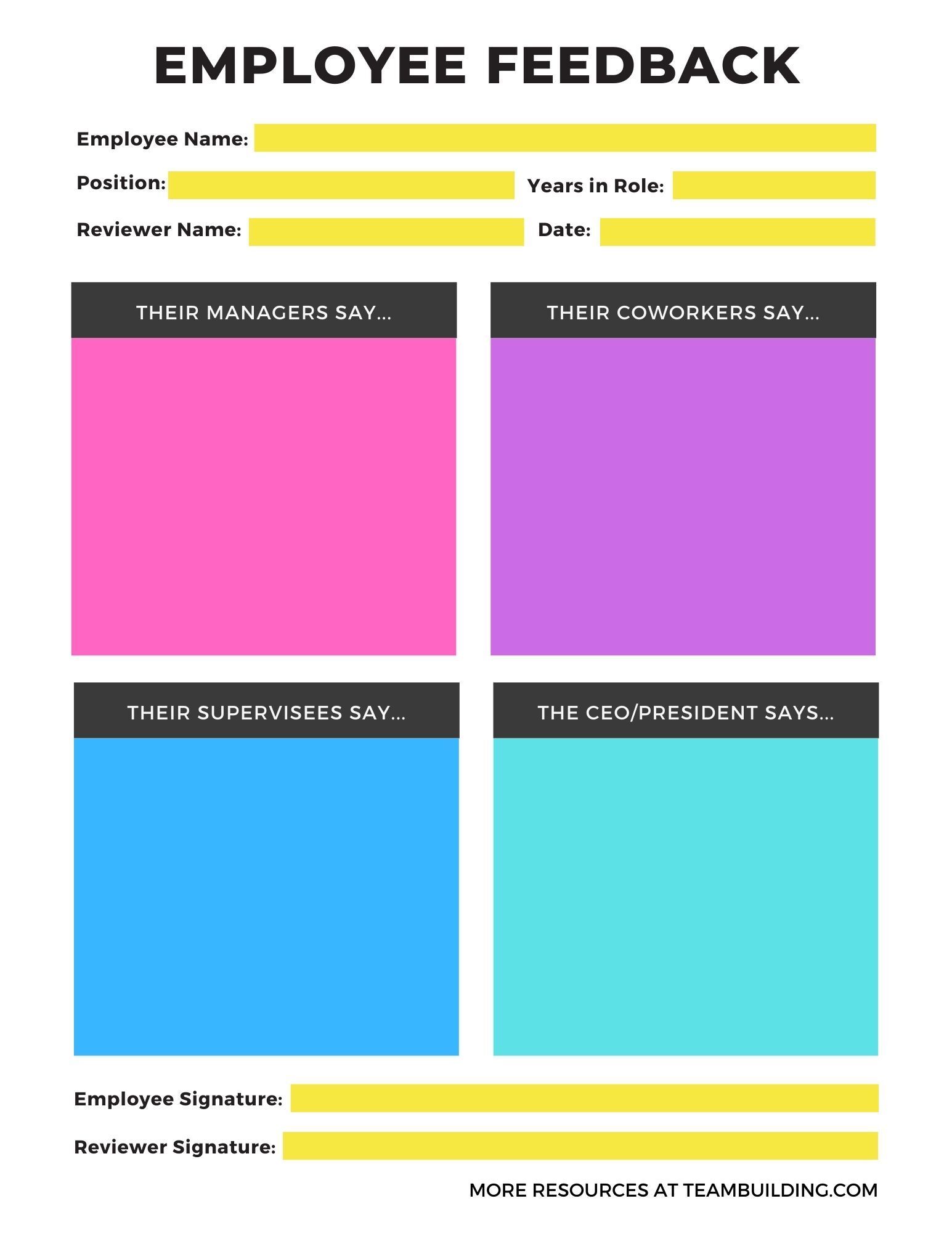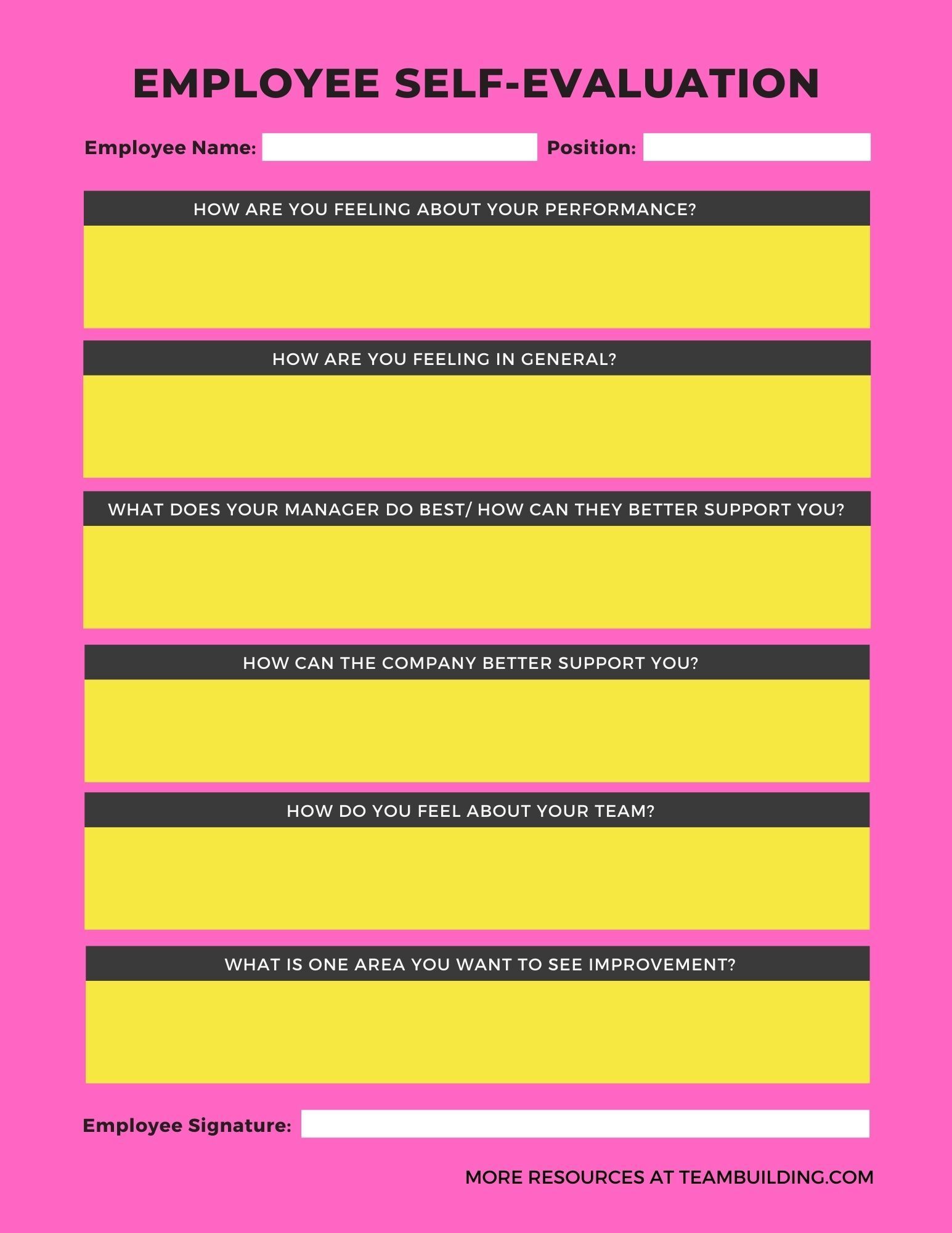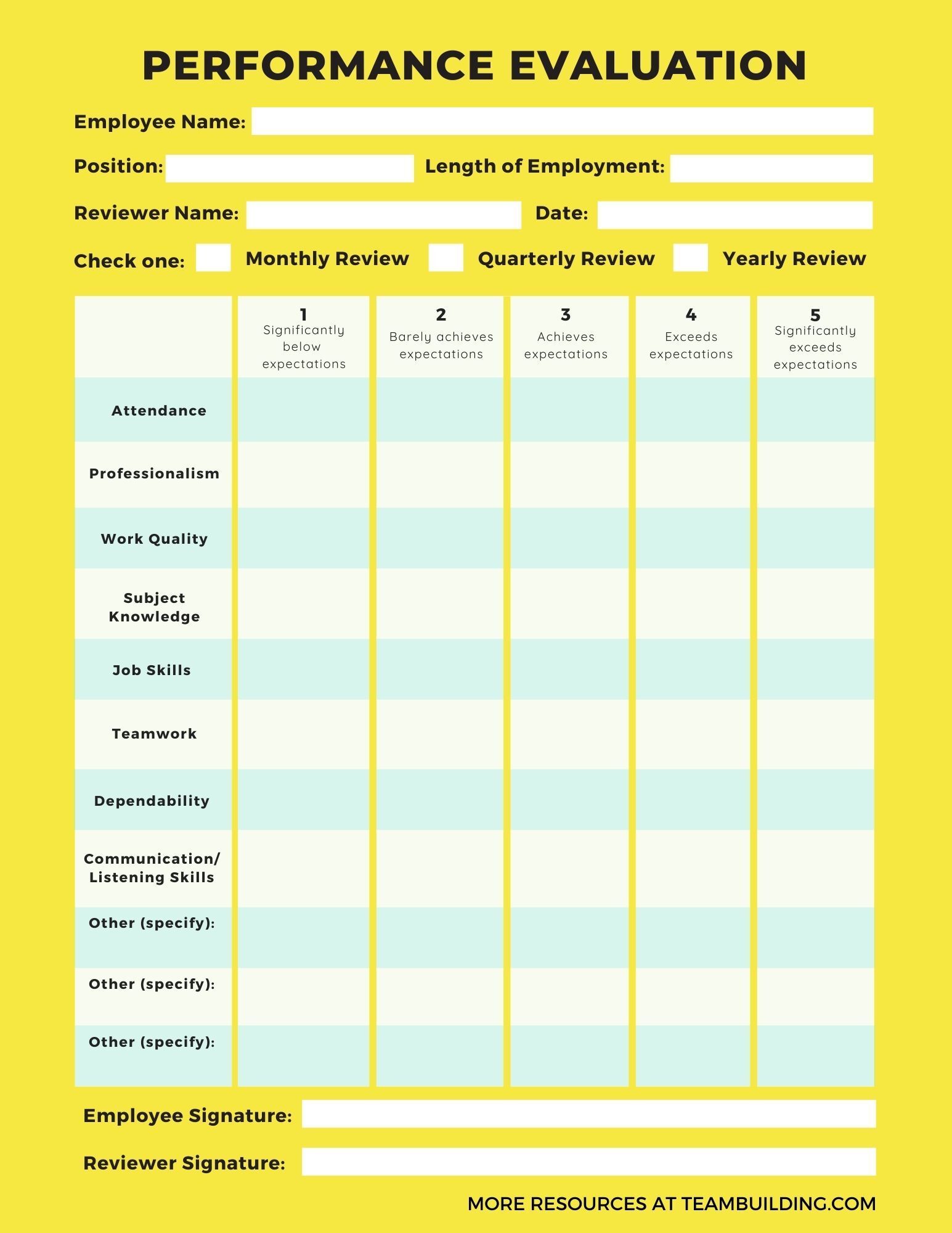You found our guide to useful employee feedback tips!
Employee feedback examples are ways to deliver constructive criticism to coworkers effectively. For example, focus on solutions, create a consistent format, and hold two way conversations. The purpose of these best practices is to help professionals deliver impactful insights that inspire colleagues to improve performance.
Delivering constructive feedback is an essential management competency that helps leaders build successful teams and coach employees.
This article includes:
- positive employee feedback examples
- employee feedback templates
- how to give feedback to employees
Here is everything you need to know.
Positive employee feedback examples
Here is a list of constructive phrases you can use in written reviews or constructive conversations.
- Arrives promptly to meetings and events and starts the work day on time
- Is available as expected and communicates any unavailability
- Exudes a positive attitude
- Continues to be a team player who supports colleagues
- Asks insightful and appropriate questions
- Provides suggestions on how to improve workplace systems
- Dresses, speaks, and behaves in a professional manner
- Conveys empathy and patience when handling clients
- Asks for help when necessary
- Delegates duties and splits work in ways that aid efficiency
- Works independently and takes initiative
- Meets deadlines with quality results
- Keeps team updated on progress
- Remains calm under pressure
- Exhibits skillful leadership
- Represents the brand appropriately
- Knows how to communicate tactfully
- Assumes extra responsibility when appropriate
- Shows sound decision making skills and good judgment
- Serves as a role model of good behavior
- Exceeds expectations in terms of goals and objectives
- Models dependability and reliability
- Takes initiative to learn and improve outside of work
- Makes good use of time and resources
- Practices solid time management
- Operates at level 10 integrity
- Compiles accurate and reliable research and data
- Maintains top tier organization
- Responds positively to constructive criticism
- Participates enthusiastically in team activities
- Treats customers, teammates, and supervisors with respect
- Solves problems with innovative solutions
- Demonstrates creativity and out-of-the-box thinking
- Lives company values and furthers organizational missions
- Displays a deep understanding of role requirements
- Stays informed about industry trends and outside influences
- Makes decisions quickly using the best information available
- Conducts thorough and reliable research
- Commits to building strong relationships with coworkers
- Relates well to others
- Exceeds expectations on goals set during performance reviews.
- Sets appropriate goals and strives to accomplish them.
- Excels at developing strategies that deliver results.
- Holds team members and self accountable
- Possesses impressive technical knowledge and skills and continues to learn
- Resolves conflicts respectfully and professionally
- Develops and maintains healthy boundaries
- Requires minimal supervision
- Produces consistent high quality work
- Strives to stay connected when working remotely
Well-written employee review phrases are clear and understandable, short yet specific. Prior to hearing these words during a review, employees should be made aware of these expectations during interviews, onboarding, and regular check-ins.
You can tweak the wording to better fit the situation and individual employee by using variations on these sayings. Feel free to create new phrases specific to your company and industry. Another review phrase best practice is to include sentences that refer to core company values.
When delivering constructive feedback, it is important to be clear about the need for improvement without using overly harsh language. Words like “never,” “subpar,” and “terrible” should be avoided, and terms like “fails” should be used with discretion. A solutions-focused voice tends to be more effective than a critical tone. Phrases like “needs improvement,” are valuable because they acknowledge shortcomings and encourage growth. Suggestions should accompany such comments. Always follow up a criticism with a conversation on how to perform better.
Finally, leave a space for additional comments at the end of the review, and always add at least once. Even if the review is flattering and positive, no employee wants to feel like a series of checkmark boxes. Personalized feedback assures the employee that his or her efforts are noticed and appreciated, and makes managers seem more invested and involved in teammates’ performance.
For similar sentiments, check out this list of employee appreciation phrases.
Employee feedback templates
Here are some templates you can use to give employees feedback.




How to give feedback to employees
We rounded up the best tips for giving employee feedback to teammates and direct reports.
1. Acknowledge that mistakes are part of the process
At TeamBuilding we believe in feedback first, which means that some failures are okay and expected. Missteps are par for the course as part of an organization that takes calculated risks, and we prefer coaching moments over consequences. When a project doesn’t work out, we treat the opportunity as a learning moment and shift the conversation towards ways to improve on similar scenarios in the future.
2. Focus on solutions
One of the best tips for giving employee feedback is to focus on solutions. Pointing out flaws and doling out punishment is likely to make staff defensive. However, if you steer the conversation towards resolution instead of retribution, employees are less likely to feel attacked. This tactic shifts staff from perpetrators to problem solvers. When employees do not feel that their jobs or reputations are at stake, they can focus fully on the task at hand. A solutions-based approach depersonalizes the problem and occupies employees’ minds with something beyond blame.
Speaking of solutions-based approaches, here is a list of problem-solving games that can help staff adopt critical thinking mindsets.
Want some free team building tools?
$49 value (100% free)
- 100+ fully tested icebreaker questions
- 24+ themed Bingo generators
- 5+ PDFs (including the 8% Rule)
- 2024 team building calendar
- and more...

Enter your email for instant access
3. Use clear and direct language
Feedback is only effective when understandable. Constructive criticism is not a time to be coy. Softening the statement may spare your team member’s feelings in the moment, but is likely to cause greater frustration down the road. Your team member may believe that they understand your intent and are complying with instructions, all while repeating the same mistakes.
When you inevitably meet to discuss the problem again, your employee may respond, “I’m doing what you told me to do,” or “why can’t you just tell me what you want?”
Many managers struggle with giving unflattering feedback. The solution is not to sugarcoat the statement, but rather to alter the tone. Feedback does not have to be harsh to be effective. In fact, insulting managers are likely in need of a talking-to themselves. There are ways to be real without being abusive. Leaders can deliver hard-to-hear messages while treating employees with respect and dignity. For example, managers can praise the positive parts of an employee’s performance while still calling for improvement in other areas.
4. Agree upon a clear plan of action
Every conversation should end with next steps. The purpose of the meeting is not merely to talk about what areas could use improvement. Feedback exists to give employees a roadmap to better performance.
Every feedback session should wrap up with clear instructions and expectations. Ideally, the manager should map out a plan for the employee to follow until the next sit down. At minimum, leaders should discuss next steps and give employees a clear idea of what actions to take post-meeting.
5. Establish a feedback loop
A feedback loop is a system where the output informs future input. In terms of business, this concept typically refers to the ways that staff or customers comments can improve operations. However, establishing a feedback loop is also the ultimate goal of employee evaluation. Teammates should take corrective action to work on the areas addressed during the assessment.
One way to ensure a feedback loop develops is to make responding to feedback a metric. In future reviews, reflect on the changes made since the last evaluation and rate the team member’s growth. Then, discuss how the employee can continue to improve.
6. Stick to a schedule
Regular feedback is the best feedback, especially when operating remotely. The nature of virtual work can lead to self-doubt. Just because an employee is competent, it doesn’t mean they are confident, and vise versa. Regular feedback gives team members the conviction and direction needed to perform their roles effectively.
The frequency of feedback often depends on company, industry, and leadership style. At bare minimum, employees should receive a formal evaluation at least once a year, coupled with the occasional “good job,” or helpful hint. Quarterly assessments are even better. Feel free to hold less structured monthly, weekly, or daily feedback sessions, group or individual, as the schedule allows. These instances do no even have to be meetings. For instance, you might send your team a weekly report or privately message teammates on Slack bi-weekly.
However often you choose to deliver feedback, try to stick to the schedule as closely as possible. Getting sidetracked is easy, especially during busy periods. As tempting as it can be to skip meetings, you should not let too much time lapse between touching base with your team. Knowing when to expect feedback eases anxiety and keeps your team in a mindset of continual improvement.
7. Hold two way conversations
Feedback functions best as a dialogue, not a monologue. Folks tend to be more receptive to criticism when they can offer suggestions in turn. Often, staff responses to criticism will reveal misunderstandings or misdiagnoses. For instance, perhaps while addressing a missed deadline, a manager discovers that a team member was under the assumption that another project took precedence.
This prompting should not serve as an opportunity for employees to make excuses. Accountability is still important. If an employee seems to be shrugging off the situation, then steer the conversation back towards solutions rather than blame or avoidance.
In a perfect format, the employee has a chance not only to respond at the end of the meeting, but to share thoughts and impressions throughout the conversation. You can also distribute employee engagement surveys outside of meetings to give staff a chance to submit anonymous feedback.
8. Schedule regular one to ones
“We need to talk,” is one of the scariest sentences known to man. When managers request meetings, many folks’ first instinct is, “I’m in trouble.” Even model employees are not immune to this anxiety. A sense of apprehension can put team members on edge and make the conversation needlessly tense.
However, when feedback arises as a part of a routine call, few alarm bells go off. Having regular one on one meetings makes feedback feel routine. In these situations, leaders can offer up constructive criticism without the advice registering as formal feedback. The critique becomes a part of the conversation instead of an event unto itself.
Not to mention, one on ones give the opportunity for more immediate feedback. Instead of having to wait for a formal assessment to occur, managers can give guidance in real time and course correct more quickly.
Here is a guide to holding virtual one to one meetings.
9. Create a consistent format
Creating a consistent format can eliminate employee dread and make the process flow much more smoothly. Perhaps you ask managers and employees to complete a questionnaire pre-meeting, and then go over the questions one at a time. Maybe the employee always speaks first. Or, perhaps you pair every piece of constructive feedback with a sincere compliment. Whatever method works best, introduce the format to the team and try never to stray too far from the system.
10. Use performance review software
While there should be a human element to performance reviews, the process does not need to be completely manual. Performance management software offers managers helpful tools to deliver or solicit feedback.
For example, many programs contain metrics that monitor and contextualize performance. Managers can use the software to organize notes, creating a handy reference for writing evaluations. Plus, employees and managers can use these platforms to easily access past reviews, making it easier to gage growth. Many of these programs even contain built-in survey tools for regular two-way feedback. Managers can use these functions to guide and structure the feedback process, eliminating the administrative hassle so that leaders can focus on coaching.
Check out this guide to HR software for performance management software suggestions.
11. Document the conversation
There are many reasons to document feedback-related conversations. In the event the encounter eventually ends in the employee’s termination, this record serves as proof that the company communicated expectations and made reasonable efforts to help the team member meet standards.
On a lighter note, the documentation can also serve as a testament to employee growth and can justify a raise or promotion.
Plus, the record can serve as a reminder of past conversations and prevent the manager from rehashing repeat topics. Or, a leader who needs to have a similar conversation with a different employee can save time by recycling successful messaging.
12. Foster peer to peer feedback
Constructive criticism does not need to come exclusively from managers. Fostering peer to peer feedback is a way to build trust and accountability among teams. Teammates who can address conflicts directly, give each other pointers, and learn from each other tend to have healthier relationships and higher productivity.
Teammate feedback should follow similar guidelines and formats as supervisor feedback. Communication should be constructive, respectful, and confidential when appropriate. Conversation should flow both ways, with every team member empowered to give kudos to or gently correct any other.
Be sure to encourage positive feedback and peer to peer praise. Getting recognition from colleagues can boost feelings of workplace satisfaction and belonging and can improve teamwork.
13. Provide genuine positive feedback
A common recommendation for giving feedback is to pair every piece of critique with praise. The compliment sandwich is probably the most popular feedback technique, wherein the speaker precedes and follows every piece of constructive criticism with a flattering comment. I would amend this advice with the caveat that every compliment should be as sincere and straightforward as possible.
Exaggerated praise does not do employees any favors. Team members crave genuine positive feedback, not fluff. Staff is likely to see through niceties meant solely to soften the blow of criticism, and may feel more offended by coddling than by critique.
If there were no redeeming parts of your employee’s performance, then you would not keep them on staff. Figure out your employee’s strengths and mention those qualities during the review. Not only will praise bolster the employee’s self esteem, it highlights areas of mastery the team member can capitalize on to fix weaknesses.
Recognition is also an important best practice for employee engagement.
14. Launch an informal feedback system
Not every piece of feedback needs to be a written review or meeting. Informal critique can take the form of a group thread, email shoutout, or field on a weekly check-in form. For example, TeamBuilding has #you-are-awesome and #feeback-first Slack channels where teammates can praise peers or pass along customer comments respectively.
Or, you can launch a virtual suggestion box where remote teammates can ask questions or make recommendations, and ask staff to use the form at least once per quarter.
Having an anytime-feedback outlet takes the pressure off of chiming in and enables teammates to pass along observations as the thoughts occur.
Final Thoughts
There is no reason to fear feedback. Constructive conversations are chances to gauge growth and evolve into better employees. More often than not, these conversations deliver reassurance and recognition and convey appreciation and gratitude. Reviews are checkpoints and opportunities for refocusing. Evaluations are a way to touch base about expectations and realign individuals goals with company objectives.
These talks are generally not about accusing workers of doing badly, but rather pointing out possible opportunities to do better and grow more quickly. There is always room for improvement, and having others around to provide feedback means that no individual has to figure out how best to grow alone.
Next, check out this guide to online meeting etiquette.
